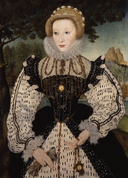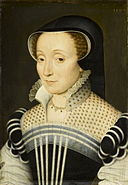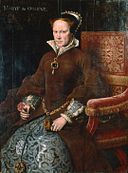Heh. it’s like an episode of CSI. get it, researching the bodies?
Anyway…I’ve decided a good blog series would be about the creation of an outfit from beginning to end. I’ll probably be doing a couple of these simultaneously, weaving in and out between different ensembles. This series will be about the creation of a late Tudor/early Elizabethan (1560’s) middle class lady’s ensemble.
Step 1: Look at portraiture of the era
For me, this is step 1. I can get an idea of the style, the fit, and what seemed “popular” at the time. From 1560’s English and French portraiture, I can see that the conical, stiff bodice shape was a la mode during this period. So first things first, I need to be able to achieve that shape. This becomes the first piece that I’ll have to make, in order to make all the other pieces fit correctly. I’ve got a couple renfaire style shifts that I can use under the garments temporarily for fittings. I’m a busty, curvy gal, and it’s pretty apparent from portraits that most of these women weren’t. Heck, most look board-flat. Taming my curves into that straight cone shape is going to take some hefty undergarments.
 |
 |
 |
Step 2: look at extant examples of corsets/bodices
Well, problem is there are none. The Eleanora of Toledo’s 1562 bodice “shows fragments of her red velvet bodice or ‘bodies’ which fastened at the front with hooks and eyes” (Anderson: Patterns of Fashion, 40). However, not enough of the bodies remain to understand how they were constructed. Because this is a Spanish find, I’m also considering it may not have the same stiffening required to achieve the English/French shape. non-English style of the time seems to be a bit more curvy and less pointy on the bodice bottom. The next pair of bodies we can view is the Pfalzgrafin bodies worn by Dorthea Sabina von Neuberg. These are dated to 1598, 38 years after my target time period.
Step 3: Research some more
Google is an amazing thing. I search for things like “pair of bodies” and look through the images, clicking on blogs and articles by other SCAdians and historical costumers who have recreated these garments. Drea Leed has an excellent overview of the history of corsets. I agree with many of her points of conjecture about what may have happened between the 1520’s and 1600 to go from a tightly fitted kirtle to the separate garment of the pair of bodies, and that shaping garments would be required for the conical shape. She also notes historical accounts of Mary’s 1550 wardrobe including references to the pair of bodies, which backs up existance for 1560.
On Sempstress.org, I found a wonderful post about recreating the curved front corset as shown in the Juan de Alcega tailor’s book and “several other period tailor’s books”. Not having access to any of these books, I’ll take her word for it. The corset seems more made to wear by a busty gal like myself. It provides the cone shape without serious squish to my hooters, and as she mentions is probably the most comfortable corset she’s ever worn. Ding! I like comfort.
I also read these items and got some ideas/background:
- Elizabethan Bodies – A Short Article
- Bodies, Stays & Corsets: A look at the female body in sixteenth century western europe – a very preliminary report
- Bodies, Stays & Corsets – a look at supportive garments in the 16th century
Step 4: Make conjectures and adjustments
Well, since I have no extant specific garments to look at for the pair of bodies, I need to gather all the information I have, and make some conjectures.
- I believe that by 1560, a separate pair of bodies garment would be possible.
- I believe that even though they aren’t shown in any period portraiture I can find, there were English and French women in the 1560’s that weren’t stick skinny and lacking breasts.
- I believe that the pointed front of the bodice would have required some form of stiffening beyond simple buckram in order not to buckle. The point is not as exaggerated as later Elizabethan styles, but is still prominent enough to be visible on portraiture that shows the waist. without some sort of boning, this point would not be achievable on a rounded body. If you’ve ever made a pointed unboned bodice, you may have seen how the bottom just bends and flips up when you sit down.
- I believe that for my body, I’m going to need some heavy duty stiffening to achieve a cone shape. I’ve certainly worn tight clothing, it doesn’t do that cone thing. Reed, a common material of the time, seems to be an ideal candidate.
- I’d like to be able to wear this in the summer at Pennsic, so I’m going to go for Linen as a material, perhaps with an outer layer of decorative fabric. Wool, while a common material, is just out of the question since I may be wearing other wool layers.
Conclusion
Okay! I’ve concluded what specifically I’m going to make, and backed up that with a bit of research to steer me in the right direction for making a period-correct(ish) garment. Next step is to gather materials and pattern out the base corset using the Custom Corset Pattern Generator.

1 comment for “Tudor Lady’s Part 1: Researching the Bodies”